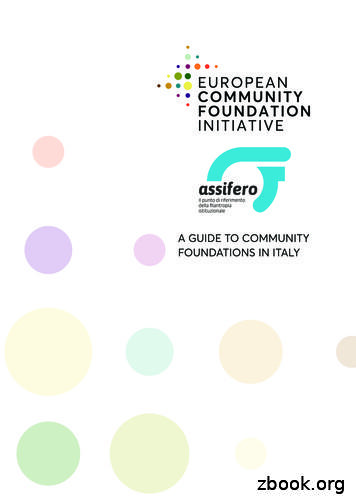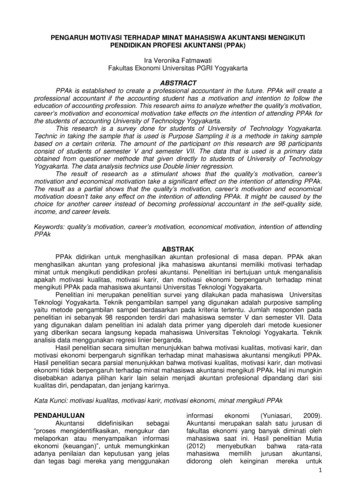Foundations Teacher’s Edition
Foundations Teacher’s EditionIntroductionThis guide explores various features in the Teacher’s Edition of theFoundations Series version of Miller & Levine Biology.It focuses on features that are unique to the Teacher’s Edition.For information on the Student Edition for the Foundations Series,please visit the Foundations Series: Student Edition tutorial onmyPearsonTraining.com.This guide will help teachers navigate the content. The following is aquick preview of each section: Front MatterThe front pages of the book include explanations of key features,National Science Education Standards, and a quick lab materialslist.Each chapter includes a chapter planner. Use it to plan instructionand target activities for differentiated instruction.When launching the chapter, help students connect with the BigIdea through prior knowledge, strategies, and activities.The teaching tools are located in the book margins and at thebottom of the pages. These include Getting Started, Pre-Reading,During-Reading, and Speed Bump.Teachers have many options for planning inquiry opportunities forclass. Lessons include open-ended and guided inquiry activities.Use assessments at the end of each lesson, chapter, and unit tomonitor student progress.Teachers just beginning their implementation of the Miller & LevineFoundations Series may have many questions about the philosophy,support materials, and teaching tools. The front pages of the Teacher’sEdition feature a wealth of information. With the book closed and spineheld down, find these sections by looking for the purple pages at thebeginning of the book.Featured articles include the following: Explanations of Understanding by Design (UbD)Descriptions of how inquiry is addressed through the programCopyright 2009 Pearson Education, Inc. or its affiliates. All rights reserved.1
Details on differentiated instruction and support for Englishlearners summaries of assessment optionsAn overview of the digital offerings available through Biology.comFor more information on these topics, view the other Miller & Levinetutorials on myPearsonTraining.com.There are a few additional resources that will help teachers as theyplan their school year. The National Science Education Standardssection identifies and correlates each standard to the appropriatechapter, lesson, and activity.Ordering lab materials for the entire school year can be a timeconsuming chore. Instead of sifting through all the chapters to make alist, teachers can simply view a handy list of Quick Lab materials thatthey will need throughout the year.Next, take a look at a Chapter Planner. This guide will be usingexamples from Chapter 10.The Chapter Planner outlines the Chapter Contents and identifies theNational Science Education Standards addressed in the chapter.Teachers can also use the planner as a pacing guide. In the Timecolumn, note the two time intervals. The top duration identifies thenumber of traditional 45–50 minute school periods needed to cover thematerial. The bottom duration identifies the amount of time neededduring a 90-minute instructional block.Copyright 2009 Pearson Education, Inc. or its affiliates. All rights reserved.2
Also notice two additional columns—the Core Resources and theAdditional Resources columns. The Core Resources column points outthe main activities teachers use during the chapter. The AdditionalResources column identifies activities that may be used to supportinstruction.Notice the red boxes at the end of many activities. These boxes arekeys to differentiated instruction. These appear throughout the chapterto assist teachers in planning for special populations.In the Core Resources section, most of the activities are labeled L2 foron-level students. However, look at the Additional Resources sectionand notice Study Workbook B 10.1 Worksheets, which are labeled L1,for special needs or struggling students. The ELL label signifies Englishlanguage learners, and LPR stands for less proficient readers.The Chapter Review Section identifies activities that help teacherswrap–up the chapter and prepare their students for the chapterassessments. Some of these activities include workbook pages, textresources, and technology connections.Note chapter assessments listed in the Chapter Assessment section.Use this information to administer differentiated assessment based onthe individual needs of students.At one point or another, teachers have probably been faced with thedilemma of being out of school for a week due to bad weather or a firedrill occurring during a biology class period. Both of these situationscan impact the biology schedule. That’s why the authors have includeda Pressed for Time section. This section suggests ways to quickly coverthe chapter material, while still addressing the key concepts.Launching aChapterAs an example, turn to Chapter 10, titled Cell Growth and Division.Each chapter has a Big Idea and is accompanied by a Big Question.These concepts are the foundation of the chapter. In the left margin,see the Connect to the Big Idea section. This feature includes anactivity for activating prior knowledge, introducing the big idea, anddiscussing the vocabulary. This particular launch activity uses a pictureof the embryonic whitefish cells.Copyright 2009 Pearson Education, Inc. or its affiliates. All rights reserved.3
To the right of the Big Idea, notice the main concepts for the chapterlessons.Each chapter begins with a Chapter Mystery. This mystery aligns to theBig Idea and concepts introduced in the chapter lessons.The Chapter Mystery for Chapter 10 is about Julia. She discoversthat one of the limbs of a salamander has been eaten off. Concernedthat the salamander might die, she places it in its own tank. She issurprised by the way the salamander’s body reacts. In the ChapterMystery, students are asked to determine how the body of thesalamander might have reacted to the loss of a limb.Throughout the chapter, students are directed back to the ChapterMystery, and they are introduced to clues that can help them solve themystery by the end of the chapter.Use the Set the Purpose section at the bottom of the page to directstudents through a preview and focus on the guiding questions of thechapter.The right margin of the book has a What’s Online section that lists thedigital resources available online at Biology.com. Direct students to thissection to view a video of the Chapter Mystery or Untamed Science.They may also visit Tutor Tube for extra help, or they can explore thechapter images in Art Review, Interactive Art, or Art in Motion. Formore information on digital components, please view the other Miller &Levine modules on myPearsonTraining.comIn this chapter, teachers can use the Foundations for Learning sectionto introduce an activity to categorize vocabulary words. This activitycontinues throughout the chapter.Copyright 2009 Pearson Education, Inc. or its affiliates. All rights reserved.4
LessonFeaturesEach lesson has five distinct features, which include the followingcomponents: Getting StartedPre-readingDuring ReadingSpeed BumpHands-on Learning ActivityGettingStartedTurn to Lesson 10.1, Cell Growth, Division, and Reproduction.Pre-readingIn the left margin, find the lesson objectives and student resources,including connections to Biology.com.DuringReadingStruggling readers will benefit from the activities presented in thePre-Reading section. Teachers can walk students through this chapterpreviewing and predicting as they go.Teachers have access to many other reading and learning strategiesin the During-Reading Activity section. Objectives of these activitiesinclude ensuring understanding of the vocabulary, building selfmonitoring and questioning strategies, and learning to make analogies.Speed BumpAt the bottom of the page, note the Speed Bump section. This sectionalerts teachers to items that may be misunderstood by students. Usethese questions to gauge their understanding. Teachers can also usethese questions to reinforce the information that was just covered.Hands-onLearningActivitySometimes students have trouble grasping a concept like surface area.The Hands-on Learning Activity is a way to make an abstract conceptmore concrete. In this activity, students determine the surface areaand volume of blocks. They also write ratios comparing surface area tovolume.InquiryOpportunitiesThe program also offers a variety of inquiry opportunities. These rangefrom open-ended activities where students design their own labs toguided inquiry where teachers ask questions and provide specificdirections.Lab explorations include pre-lab activities, lab procedures, and followup activities.AssessmentAt the end of each lesson there are section assessments that will helpteachers monitor student understanding. These sections revisit thekey concepts of the lesson. Use the Mystery Clue to initiate a classdiscussion that will help students connect the lesson content back tothe Chapter Mystery.Copyright 2009 Pearson Education, Inc. or its affiliates. All rights reserved.5
The Chapter Summary occurs at the end of the chapter and lists themain ideas and vocabulary of each lesson. It includes PerformanceTasks that help students review and make connections to the chaptercontent. In this chapter, teachers will ask students to compare cellsthat regenerate in humans and in salamanders. The chapter summaryalso provides review resources that are available on Biology.com.The Check Understanding section allows students to review keyconcepts and think critically about what they have learned. TheTeacher’s Edition provides teachers with alternative strategies to usewith different types of learners. They may use visuals, models, or havestudents respond to alternate questions.Each chapter ends with Standardized Test Prep.These multiple-choice questions prepare students for state testing.Students having trouble answering questions may use the If You HaveTrouble With section. This section directs them back to the lessons thataddress the problem. The Teacher’s Edition provides test-taking tips inthis section. Introduce students to strategies, such as eliminating theobvious wrong answers and interpreting visuals.ReviewThis guide explored the following Teacher’s Edition features: Front pages of the bookChapter plannerLaunching the chapter with the Big Idea and the Chapter MysteryTeaching tools, such as Getting Started, Pre-Reading, DuringReading, and Speed BumpInquiry opportunitiesAssessmentsFor more information, please view the other Miller & Levine Biologytutorials on myPearsonTraining.com.Copyright 2009 Pearson Education, Inc. or its affiliates. All rights reserved.6
Foundations Series version of Miller & Levine Biology. It focuses on features that are unique to the Teacher’s Edition. For information on the Student Edition for the Foundations Series, please visit the Foundations Series: Student Edition tutorial on myPearsonTraining.com. This guide will help teachers navigate the content. The following is a
RP 2K, Second Edition RP 2L, Third Edition RP 2M, First Edition Bul 2N, First Edition RP 2P, Second Edition RP 2Q, Second Edition RP 2R, First Edition RP 2T, First Edition Bul 2U, First Edition Bul 2V, First Edition Spec 2W, First Edition RP 2X, First Edition, with Supp 1 Spec 2Y, First Edition
Fifth Edition 1977–1978 Sixth Edition 1979–1980 Seventh Edition 1981–1982 Eighth Edition 1983–1986 Ninth Edition 1987–1988 Tenth Edition 1989–1990 Eleventh Edition 1991–1992 Twelfth Edition 1993–1994 Thirteenth Edition 1995–1996 Fourteenth Edition 1997–1998 Fifteenth Edition
Independent Personal Pronouns Personal Pronouns in Hebrew Person, Gender, Number Singular Person, Gender, Number Plural 3ms (he, it) א ִוה 3mp (they) Sֵה ,הַָּ֫ ֵה 3fs (she, it) א O ה 3fp (they) Uֵה , הַָּ֫ ֵה 2ms (you) הָּ תַא2mp (you all) Sֶּ תַא 2fs (you) ְ תַא 2fp (you
In contrast, pile-supported foundations transmit design loads into the adjacent soil mass through pile friction, end bearing, or both. This chapter addresses footing foundations. Pile foundations are covered in Chapter 5, Pile Foundations-General. Each individual footing foundation must be sized so that the maximum soil-bearing pressure does not exceed the allowable soil bearing capacity of .
It is an honour for Assifero to present this guide to community foundations in Italy. The community philanthropy movement is growing rapidly all over the world. In Italy, the establishment of community foundations began in 1999 with foundations in Lecco and Como. There are now 37 registered Italian community foundations (based on the atlas of
2. Pittsburgh Modified Conners Teacher Rating Scale 3. Parent/Teacher DBD Rating Scale 4. Child Behavior Check List- Teacher Report Form 5. Narrative Description of Child -- Teacher 6. Academic and Behavioral Target Form 7. Classroom Management Techniques Generally, the teacher rating scales should be completed by the teacher who spends the .
Wendy Lloyd, Teacher Emily Johnson, Teacher Lora McFarland, Teacher Jenna Miller, Psychologist Anne Nelson, Teacher Lacie North, Teacher Tricia Pearson, SLP Sally Rogers, Teacher Kristen Sessions, Teacher Emily Shaw, SLP Bailee VanZeben, Teacher Kristen Walters, SLP L
sistem pendidikan akuntansi (Dian, 2012). Mengingat pentingnya PPAk bagi mahasiswa akuntansi maka diperlukan motivasi dari dalam diri mahasiswa terhadap minat untuk mengikuti PPAk. Minat merupakan keinginan yang timbul dari dalam diri mahasiswa untuk mengikuti pendidikan profesi, di mana minat setiap mahasiswa sangatlah beragam hal tersebut tergantung pada pribadi masing-masing mahasiswa .























